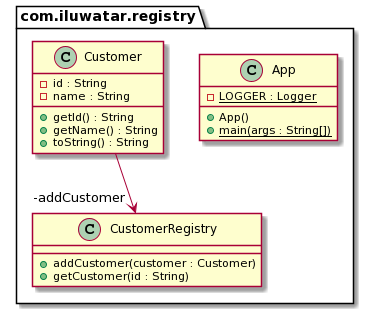Registry
On this page
Intent
Stores the objects of a single class and provide a global point of access to them. Similar to Multiton pattern, only difference is that in a registry there is no restriction on the number of objects.
Explanation
In Plain Words
Registry is a well-known object that other objects can use to find common objects and services.
Programmatic Example
Below is a Customer Class
1public class Customer {
2
3 private final String id;
4 private final String name;
5
6 public Customer(String id, String name) {
7 this.id = id;
8 this.name = name;
9 }
10
11 public String getId() {
12 return id;
13 }
14
15 public String getName() {
16 return name;
17 }
18
19}
This registry of the Customer objects is CustomerRegistry
1public final class CustomerRegistry {
2
3 private static final CustomerRegistry instance = new CustomerRegistry();
4
5 public static CustomerRegistry getInstance() {
6 return instance;
7 }
8
9 private final Map<String, Customer> customerMap;
10
11 private CustomerRegistry() {
12 customerMap = new ConcurrentHashMap<>();
13 }
14
15 public Customer addCustomer(Customer customer) {
16 return customerMap.put(customer.getId(), customer);
17 }
18
19 public Customer getCustomer(String id) {
20 return customerMap.get(id);
21 }
22
23}
Class diagram

Applicability
Use Registry pattern when
- client wants reference of some object, so client can lookup for that object in the object’s registry.
Consequences
Large number of bulky objects added to registry would result in a lot of memory consumption as objects in the registry are not garbage collected.